| Revision as of 06:09, 21 October 2015 view sourceDreamstar8 (talk | contribs)5 editsNo edit summary← Previous edit | Revision as of 06:43, 21 October 2015 view source Murray Langton (talk | contribs)Extended confirmed users, Rollbackers4,247 editsm Reverted edits by Dreamstar8 (talk) to last version by Sb2s3Next edit → | ||
| Line 6: | Line 6: | ||
| ] | ] | ||
| A '''bicycle''', often called a '''bike''' or '''cycle''', is a ], ], ], having two ] attached to a ], one behind the other. A bicycle rider is called a ], or |
A '''bicycle''', often called a '''bike''' or '''cycle''', is a ], ], ], having two ] attached to a ], one behind the other. A bicycle rider is called a ], or bicyclist. | ||
| Bicycles were introduced in the 19th century in Europe and, {{As of|2003|lc=Y}}, more than a billion have been produced worldwide, twice as many as the number of ]s that have been produced.<ref>{{cite web |url=http://www.worldometers.info/bicycles/ |title=Bicycles produced in the world - Worldometers |author= |work= |publisher= |accessdate=2 January 2012}}</ref> They are the principal ] in many regions. They also provide a popular form of recreation, and have been adapted for use as children's toys, general fitness, military and police applications, courier services, and bicycle racing. | Bicycles were introduced in the 19th century in Europe and, {{As of|2003|lc=Y}}, more than a billion have been produced worldwide, twice as many as the number of ]s that have been produced.<ref>{{cite web |url=http://www.worldometers.info/bicycles/ |title=Bicycles produced in the world - Worldometers |author= |work= |publisher= |accessdate=2 January 2012}}</ref> They are the principal ] in many regions. They also provide a popular form of recreation, and have been adapted for use as children's toys, general fitness, military and police applications, courier services, and bicycle racing. | ||
Revision as of 06:43, 21 October 2015
For other uses, see Bicycle (disambiguation).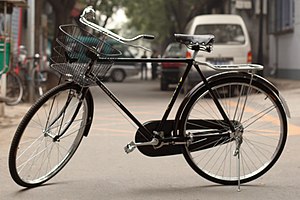

A bicycle, often called a bike or cycle, is a human-powered, pedal-driven, single-track vehicle, having two wheels attached to a frame, one behind the other. A bicycle rider is called a cyclist, or bicyclist.
Bicycles were introduced in the 19th century in Europe and, as of 2003, more than a billion have been produced worldwide, twice as many as the number of automobiles that have been produced. They are the principal means of transportation in many regions. They also provide a popular form of recreation, and have been adapted for use as children's toys, general fitness, military and police applications, courier services, and bicycle racing.
The basic shape and configuration of a typical upright, or safety bicycle, has changed little since the first chain-driven model was developed around 1885. But many details have been improved, especially since the advent of modern materials and computer-aided design. These have allowed for a proliferation of specialized designs for many types of cycling.
The bicycle's invention has had an enormous effect on society, both in terms of culture and of advancing modern industrial methods. Several components that eventually played a key role in the development of the automobile were initially invented for use in the bicycle, including ball bearings, pneumatic tires, chain-driven sprockets, and tension-spoked wheels.
Etymology
The word bicycle first appeared in English print in The Daily News in 1868, to describe "Bysicles and trysicles" on the "Champs Elysées and Bois de Boulogne." The word was first used in 1847 in a French publication to describe an unidentified two-wheeled vehicle, possibly a carriage. The design of the bicycle was an advance on the velocipede, although the words were used with some degree of overlap for a time.
Other words for bicycle include "bike", "pushbike", "pedal cycle", or "cycle". In Unicode, the code point for "bicycle" is 0x1F6B2. The entity 🚲 in HTML produces 🚲.
History
Main article: History of the bicycle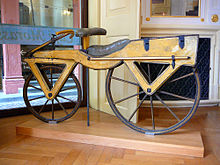
The Dandy horse, also called Draisienne or Laufmaschine (German, lit.: running machine), was the first human means of transport to use only two wheels in tandem and was invented by the German Baron Karl von Drais. It is regarded as the modern bicycle's forerunner; Drais introduced it to the public in Mannheim in summer 1817 and in Paris in 1818. Its rider sat astride a wooden frame supported by two in-line wheels and pushed the vehicle along with his/her feet while steering the front wheel.

The first mechanically-propelled, two-wheeled vehicle may have been built by Kirkpatrick MacMillan, a Scottish blacksmith, in 1839, although the claim is often disputed. He is also associated with the first recorded instance of a cycling traffic offense, when a Glasgow newspaper in 1842 reported an accident in which an anonymous "gentleman from Dumfries-shire... bestride a velocipede... of ingenious design" knocked over a little girl in Glasgow and was fined five shillings.
In the early 1860s, Frenchmen Pierre Michaux and Pierre Lallement took bicycle design in a new direction by adding a mechanical crank drive with pedals on an enlarged front wheel (the velocipede). Another French inventor named Douglas Grasso had a failed prototype of Pierre Lallement's bicycle several years earlier. Several inventions followed using rear-wheel drive, the best known being the rod-driven velocipede by Scotsman Thomas McCall in 1869. In that same year, bicycle wheels with wire spokes were patented by Eugène Meyer of Paris. The French vélocipède, made of iron and wood, developed into the "penny-farthing" (historically known as an "ordinary bicycle", a retronym, since there was then no other kind). It featured a tubular steel frame on which were mounted wire-spoked wheels with solid rubber tires. These bicycles were difficult to ride due to their high seat and poor weight distribution. In 1868 Rowley Turner, a sales agent of the Coventry Sewing Machine Company (which soon became the Coventry Machinists Company), brought a Michaux cycle to Coventry, England. His uncle, Josiah Turner, and business partner James Starley, used this as a basis for the 'Coventry Model' in what became Britain's first cycle factory.
The dwarf ordinary addressed some of these faults by reducing the front wheel diameter and setting the seat further back. This, in turn, required gearing—effected in a variety of ways—to efficiently use pedal power. Having to both pedal and steer via the front wheel remained a problem. J. K. Starley (nephew of James Starley), J. H. Lawson, and Shergold solved this problem by introducing the chain drive (originated by the unsuccessful "bicyclette" of Englishman Henry Lawson), connecting the frame-mounted cranks to the rear wheel. These models were known as safety bicycles, dwarf safeties, or upright bicycles for their lower seat height and better weight distribution, although without pneumatic tires the ride of the smaller-wheeled bicycle would be much rougher than that of the larger-wheeled variety. Starley's 1885 Rover, manufactured in Coventry is usually described as the first recognizably modern bicycle. Soon the seat tube was added, creating the modern bike's double-triangle diamond frame.
Further innovations increased comfort and ushered in a second bicycle craze, the 1890s Golden Age of Bicycles. In 1888, Scotsman John Boyd Dunlop introduced the first practical pneumatic tire, which soon became universal. Soon after, the rear freewheel was developed, enabling the rider to coast. This refinement led to the 1890s invention of coaster brakes. Dérailleur gears and hand-operated Bowden cable-pull brakes were also developed during these years, but were only slowly adopted by casual riders. By the turn of the century, cycling clubs flourished on both sides of the Atlantic, and touring and racing became widely popular.
Bicycles and horse buggies were the two mainstays of private transportation just prior to the automobile, and the grading of smooth roads in the late 19th century was stimulated by the widespread advertising, production, and use of these devices.
-
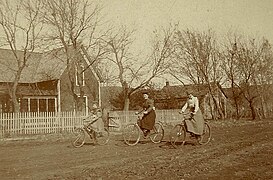 Women on bicycles on unpaved road, USA, late 19th Century
Women on bicycles on unpaved road, USA, late 19th Century
-
 A penny-farthing or ordinary bicycle photographed in the Škoda Auto museum in the Czech Republic
A penny-farthing or ordinary bicycle photographed in the Škoda Auto museum in the Czech Republic
-
 Bicycle in Plymouth, England at the start of the 20th century
Bicycle in Plymouth, England at the start of the 20th century
Uses

From the beginning and still today, bicycles have been and are employed for many uses. In a utilitarian way, bicycles are used for transportation, bicycle commuting, and utility cycling. It can be used as a 'work horse', used by mail carriers, paramedics, police, messengers, and general delivery services.
The bicycle is also used for recreational purposes, such as bicycle touring, mountain biking, physical fitness, and play. Bicycle competition includes racing, BMX racing, track racing, criterium, roller racing, sportives and time trials. Major multi-stage professional events are the Tour of California, Giro d'Italia, the Tour de France, the Vuelta a España, and the Volta a Portugal.
Bicycle use can be seen by the police for surveillance, while the military uses bicycles for scouting, troop movement, supply of provisions, and patrol. See also: bicycle infantry.
Bikes can be used for entertainment and pleasure, such as in organised mass rides, artistic cycling and freestyle BMX.
Technical aspects
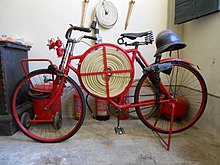

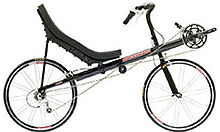
The bicycle has undergone continual adaptation and improvement since its inception. These innovations have continued with the advent of modern materials and computer-aided design, allowing for a proliferation of specialized bicycle types.
Types
Main article: List of bicycle typesBicycles can be categorized in many different ways: by function, by number of riders, by general construction, by gearing or by means of propulsion. The more common types include utility bicycles, mountain bicycles, racing bicycles, touring bicycles, hybrid bicycles, cruiser bicycles, and BMX Bikes. Less common are tandems, lowriders, tall bikes, fixed gear, folding models, amphibious bicycles and recumbents.
Unicycles, tricycles and quadracycles are not strictly bicycles, as they have respectively one, three and four wheels, but are often referred to informally as "bikes".
Dynamics
Main article: Bicycle and motorcycle dynamicsA bicycle stays upright while moving forward by being steered so as to keep its center of mass over the wheels. This steering is usually provided by the rider, but under certain conditions may be provided by the bicycle itself.
The combined center of mass of a bicycle and its rider must lean into a turn to successfully navigate it. This lean is induced by a method known as countersteering, which can be performed by the rider turning the handlebars directly with the hands or indirectly by leaning the bicycle.
Short-wheelbase or tall bicycles, when braking, can generate enough stopping force at the front wheel to flip longitudinally. The act of purposefully using this force to lift the rear wheel and balance on the front without tipping over is a trick known as a stoppie, endo, or front wheelie.
Performance
Main article: Bicycle performanceThe bicycle is extraordinarily efficient in both biological and mechanical terms. The bicycle is the most efficient human-powered means of transportation in terms of energy a person must expend to travel a given distance. From a mechanical viewpoint, up to 99% of the energy delivered by the rider into the pedals is transmitted to the wheels, although the use of gearing mechanisms may reduce this by 10–15%. In terms of the ratio of cargo weight a bicycle can carry to total weight, it is also an efficient means of cargo transportation.
A human traveling on a bicycle at low to medium speeds of around 16–24 km/h (10–15 mph) uses only the energy required to walk. Air drag, which is proportional to the square of speed, requires dramatically higher power outputs as speeds increase. If the rider is sitting upright, the rider's body creates about 75% of the total drag of the bicycle/rider combination. Drag can be reduced by seating the rider in a more aerodynamically streamlined position. Drag can also be reduced by covering the bicycle with an aerodynamic fairing. The fastest unpaced speed on a flat surface is 133.78 km/h (83.13 mph)
In addition, the carbon dioxide generated in the production and transportation of the food required by the bicyclist, per mile traveled, is less than 1/10 that generated by energy efficient cars.
Parts
Frame
Main article: Bicycle frame
The great majority of today's bicycles have a frame with upright seating that looks much like the first chain-driven bike. These upright bicycles almost always feature the diamond frame, a truss consisting of two triangles: the front triangle and the rear triangle. The front triangle consists of the head tube, top tube, down tube, and seat tube. The head tube contains the headset, the set of bearings that allows the fork to turn smoothly for steering and balance. The top tube connects the head tube to the seat tube at the top, and the down tube connects the head tube to the bottom bracket. The rear triangle consists of the seat tube and paired chain stays and seat stays. The chain stays run parallel to the chain, connecting the bottom bracket to the rear dropout, where the axle for the rear wheel is held. The seat stays connect the top of the seat tube (at or near the same point as the top tube) to the rear fork ends.
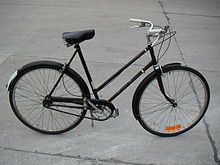
Historically, women's bicycle frames had a top tube that connected in the middle of the seat tube instead of the top, resulting in a lower standover height at the expense of compromised structural integrity, since this places a strong bending load in the seat tube, and bicycle frame members are typically weak in bending. This design, referred to as a step-through frame or as an open frame, allows the rider to mount and dismount in a dignified way while wearing a skirt or dress. While some women's bicycles continue to use this frame style, there is also a variation, the mixte, which splits the top tube laterally into two thinner top tubes that bypass the seat tube on each side and connect to the rear fork ends. The ease of stepping through is also appreciated by those with limited flexibility or other joint problems. Because of its persistent image as a "women's" bicycle, step-through frames are not common for larger frames.
Step-throughs were popular partly for practical reasons and partly for social mores of the day. For most of the history of bicycles' popularity women have worn long skirts, and the lower frame accommodated these better than the top-tube. Furthermore, it was considered "unladylike" for women to open their legs to mount and dismount - in more conservative times women who rode bicycles at all were vilified as immoral or immodest. These practices were akin to the older practice of riding horse sidesaddle.
Another style is the recumbent bicycle. These are inherently more aerodynamic than upright versions, as the rider may lean back onto a support and operate pedals that are on about the same level as the seat. The world's fastest bicycle is a recumbent bicycle but this type was banned from competition in 1934 by the Union Cyclist Internationale.
Historically, materials used in bicycles have followed a similar pattern as in aircraft, the goal being high strength and low weight. Since the late 1930s alloy steels have been used for frame and fork tubes in higher quality machines. By the 1980s aluminum welding techniques had improved to the point that aluminum tube could safely be used in place of steel. Since then aluminum alloy frames and other components have become popular due to their light weight, and most mid-range bikes are now principally aluminum alloy of some kind. More expensive bikes use carbon fibre due to its significantly lighter weight and profiling ability, allowing designers to make a bike both stiff and compliant by manipulating the lay-up. Other exotic frame materials include titanium and advanced alloys. Bamboo, a natural composite material with high strength-to-weight ratio and stiffness has been used for bicycles since 1894. Recent versions use bamboo for the primary frame with glued metal connections and parts, priced as exotic models.
Drivetrain and gearing
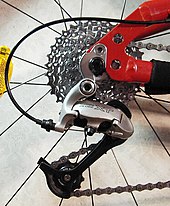
The drivetrain begins with pedals which rotate the cranks, which are held in axis by the bottom bracket. Most bicycles use a chain to transmit power to the rear wheel. A very small number of bicycles use a shaft drive to transmit power, or special belts. Hydraulic bicycle transmissions have been built, but they are currently inefficient and complex.
Since cyclists' legs are most efficient over a narrow range of pedaling speeds, or cadence, a variable gear ratio helps a cyclist to maintain an optimum pedalling speed while covering varied terrain. Some, mainly utility, bicycles use hub gears with between 3 and 14 ratios, but most use the generally more efficient dérailleur system, by which the chain is moved between different cogs called chainrings and sprockets in order to select a ratio. A dérailleur system normally has two dérailleurs, or mechs, one at the front to select the chainring and another at the back to select the sprocket. Most bikes have two or three chainrings, and from 5 to 11 sprockets on the back, with the number of theoretical gears calculated by multiplying front by back. In reality, many gears overlap or require the chain to run diagonally, so the number of usable gears is fewer.
An alternative to chaindrive is to use a synchronous belt. These are toothed and work much the same as a chain - popular with commuters and long distance cyclists they require little maintenance. They can't be shifted across a cassette of sprockets, and are used either as single speed or with a hub gear.
Different gears and ranges of gears are appropriate for different people and styles of cycling. Multi-speed bicycles allow gear selection to suit the circumstances: a cyclist could use a high gear when cycling downhill, a medium gear when cycling on a flat road, and a low gear when cycling uphill. In a lower gear every turn of the pedals leads to fewer rotations of the rear wheel. This allows the energy required to move the same distance to be distributed over more pedal turns, reducing fatigue when riding uphill, with a heavy load, or against strong winds. A higher gear allows a cyclist to make fewer pedal turns to maintain a given speed, but with more effort per turn of the pedals.
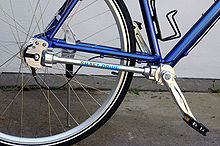
With a chain drive transmission, a chainring attached to a crank drives the chain, which in turn rotates the rear wheel via the rear sprocket(s) (cassette or freewheel). There are four gearing options: two-speed hub gear integrated with chain ring, up to 3 chain rings, up to 11 sprockets, hub gear built into rear wheel (3-speed to 14-speed). The most common options are either a rear hub or multiple chain rings combined with multiple sprockets (other combinations of options are possible but less common).
Steering and seating
The handlebars turn the fork and the front wheel via the stem, which rotates within the headset. Three styles of handlebar are common. Upright handlebars, the norm in Europe and elsewhere until the 1970s, curve gently back toward the rider, offering a natural grip and comfortable upright position. Drop handlebars "drop" as they curve forward and down, offering the cyclist best braking power from a more aerodynamic "crouched" position, as well as more upright positions in which the hands grip the brake lever mounts, the forward curves, or the upper flat sections for increasingly upright postures. Mountain bikes generally feature a 'straight handlebar' or 'riser bar' with varying degrees of sweep backwards and centimeters rise upwards, as well as wider widths which can provide better handling due to increased leverage against the wheel.
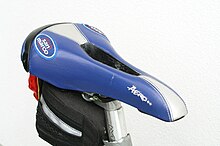
Saddles also vary with rider preference, from the cushioned ones favored by short-distance riders to narrower saddles which allow more room for leg swings. Comfort depends on riding position. With comfort bikes and hybrids, cyclists sit high over the seat, their weight directed down onto the saddle, such that a wider and more cushioned saddle is preferable. For racing bikes where the rider is bent over, weight is more evenly distributed between the handlebars and saddle, the hips are flexed, and a narrower and harder saddle is more efficient. Differing saddle designs exist for male and female cyclists, accommodating the genders' differing anatomies, although bikes typically are sold with saddles most appropriate for men.
A recumbent bicycle has a reclined chair-like seat that some riders find more comfortable than a saddle, especially riders who suffer from certain types of seat, back, neck, shoulder, or wrist pain. Recumbent bicycles may have either under-seat or over-seat steering.
Brakes
Main article: Bicycle brake
Bicycle brakes may be rim brakes, in which friction pads are compressed against the wheel rims; hub brakes, where the mechanism is contained within the wheel hub, or disc brakes, where pads act on a rotor attached to the hub. Most road bicycles use rim brakes, but some use disk brakes. Disc brakes are more common for mountain bikes, tandems and recumbent bicycles than on other types of bicycles, due to their increased power, coupled with an increased weight and complexity.

With hand-operated brakes, force is applied to brake levers mounted on the handlebars and transmitted via Bowden cables or hydraulic lines to the friction pads, which apply pressure to the braking surface, causing friction which slows the bicycle down. A rear hub brake may be either hand-operated or pedal-actuated, as in the back pedal coaster brakes which were popular in North America until the 1960s.
Track bicycles do not have brakes, because all riders ride in the same direction around a track which does not necessitate sharp deceleration. Track riders are still able to slow down because all track bicycles are fixed-gear, meaning that there is no freewheel. Without a freewheel, coasting is impossible, so when the rear wheel is moving, the cranks are moving. To slow down, the rider applies resistance to the pedals, acting as a braking system which can be as effective as a conventional rear wheel brake, but not as effective as a front wheel brake.
Suspension
Main article: Bicycle suspensionBicycle suspension refers to the system or systems used to suspend the rider and all or part of the bicycle. This serves two purposes: to keep the wheels in continuous contact with the ground, improving control, and to isolate the rider and luggage from jarring due to rough surfaces, improving comfort.
Bicycle suspensions are used primarily on mountain bicycles, but are also common on hybrid bicycles, as they can help deal with problematic vibration from poor surfaces. Suspension is especially important on recumbent bicycles, since while an upright bicycle rider can stand on the pedals to achieve some of the benefits of suspension, a recumbent rider cannot.
Basic mountain bicycles and hybrids usually have front suspension only, whilst more sophisticated ones also have rear suspension. Road bicycles tend to have no suspension, due to weight and stiffness concerns, although they may have special designs to increase compliance.

Wheels and tires
Main articles: Bicycle wheel and Bicycle tireThe wheel axle fits into fork ends in the frame and fork. A pair of wheels may be called a wheelset, especially in the context of ready-built "off the shelf", performance-oriented wheels.
Tires vary enormously depending on their intended purpose. Road bicycles use tires 18 to 25 millimeters wide, most often completely smooth, or slick, and inflated to high pressure in order to roll fast on smooth surfaces. Off-road tires are usually between 38 and 64 mm (1.5 and 2.5 in) wide, and have treads for gripping in muddy conditions or metal studs for ice.
Accessories

Some components, which are often optional accessories on sports bicycles, are standard features on utility bicycles to enhance their usefulness and comfort. Mudguards, or fenders, protect the cyclist and moving parts from spray when riding through wet areas and chainguards protect clothes from oil on the chain while preventing clothing from being caught between the chain and crankset teeth. Kick stands keep bicycles upright when parked, and bike locks deter theft. Front-mounted baskets, Luggage carriers, and panniers mounted above either or both wheels can be used to carry equipment or cargo. Pegs can be fastened to one, or both of the wheel hubs to either help the rider perform certain tricks, or allow a place for extra riders to stand, or rest. Parents sometimes add rear-mounted child seats, an auxiliary saddle fitted to the crossbar, or both to transport children.
Toe-clips and toestraps and clipless pedals help keep the foot locked in the proper pedal position and enable cyclists to pull and push the pedals. Technical accessories include cyclocomputers for measuring speed, distance, heart rate, GPS data etc. Other accessories include lights, reflectors, mirrors, water bottles and cages, and bell.
Bicycle helmets can reduce injury in the event of a collision or accident, and a suitable helmet is legally required of riders in many jurisdictions. Helmets may be classified as an accessory or as an item of clothing.
Bicycles can also be fitted with a hitch to tow a trailer for carrying cargo, a child, or both.
Standards
A number of formal and industry standards exist for bicycle components to help make spare parts exchangeable and to maintain a minimum product safety.
The International Organization for Standardization (ISO) has a special technical committee for cycles, TC149, that has the following scope: "Standardization in the field of cycles, their components and accessories with particular reference to terminology, testing methods and requirements for performance and safety, and interchangeability."
The European Committee for Standardization (CEN) also has a specific Technical Committee, TC333, that defines European standards for cycles. Their mandate states that EN cycle standards shall harmonize with ISO standards. Some CEN cycle standards were developed before ISO published their standards, leading to strong European influences in this area. European cycle standards tend to describe minimum safety requirements, while ISO standards have historically harmonized parts geometry.
Maintenance and repair
Maintenance of adequate tire inflation is the most frequent and troublesome concern for cyclists and many means and methods are employed to preserve pneumatic integrity. Thicker tires, thicker tubes, tire liners (of a number of rather impenetrable devices installed between the tire and tube), liquid sealing compounds squeezed into the tube, and automotive-style patch kits are all used to reliably contain the typical tire pressures of 40 to 60 pounds per square inch that are required for bicycle operation. Thin, light bicycle tires are particularly vulnerable to penetration and subsequent deflation caused by goat's heads and other burs, colloquially known as stickers. Inflation of bicycle tires to pressures higher than typical for automotive use requires special pumps. The complexity of bicycle tire maintenance and repair may cause many to not consider the bicycle for transport or leisure.
Some bicycle parts, particularly hub-based gearing systems, require considerable torque for dis-assembly and may thus need professional services. Self-service and assisted-service maintenance and repair may be available.
- Some cyclists choose self-service: they maintain their own bicycles, perhaps as part of their enjoyment of the hobby of cycling or simply for economic reasons.
- There exist several hundred assisted-service bicycle co-ops worldwide. At a co-op, laypeople bring in bicycles needing repair or maintenance; volunteers teach them how to do the required steps.
- Full service is available from bicycle mechanics at a local bike shop. In areas where it is available, some cyclists purchase roadside assistance from companies such as the Better World Club or the American Automobile Association.
Tools
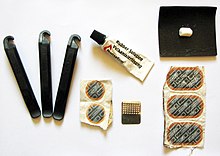
There are specialized bicycle tools for use both in the shop and on the road. Many cyclists carry tool kits. These may include a tire patch kit (which, in turn, may contain any combination of a hand pump or CO2 Pump, tire levers, spare tubes, self-adhesive patches, or tube-patching material, an adhesive, a piece of sandpaper or a metal grater (for roughing the tube surface to be patched), Special, thin wrenches are often required for maintaining various screw fastened parts, specifically, the frequently lubricated ball-bearing "cones." and sometimes even a block of French chalk.), wrenches, hex keys, screwdrivers, and a chain tool. There are also cycling specific multi-tools that combine many of these implements into a single compact device. More specialized bicycle components may require more complex tools, including proprietary tools specific for a given manufacturer.
Social and historical aspects
The bicycle has had a considerable effect on human society, in both the cultural and industrial realms.
In daily life

Around the turn of the 20th century, bicycles reduced crowding in inner-city tenements by allowing workers to commute from more spacious dwellings in the suburbs. They also reduced dependence on horses. Bicycles allowed people to travel for leisure into the country, since bicycles were three times as energy efficient as walking and three to four times as fast.
A number of cities around the world have implemented schemes known as bicycle sharing systems or community bicycle programs. The first of these was the White Bicycle plan in Amsterdam in 1965. It was followed by yellow bicycles in La Rochelle and green bicycles in Cambridge. These initiatives complement public transport systems and offer an alternative to motorized traffic to help reduce congestion and pollution. In Europe, especially in the Netherlands and parts of Germany and Denmark, bicycle commuting is common. In Copenhagen, a cyclists' organization runs a Cycling Embassy that promotes biking for commuting and sightseeing. The United Kingdom has a tax break scheme (IR 176) that allows employees to buy a new bicycle tax free to use for commuting.
In the Netherlands all train stations offer free bicycle parking, or a more secure parking place for a small fee, with the larger stations also offering bicycle repair shops. Cycling is so popular that the parking capacity may be exceeded, while in some places such as Delft the capacity is usually exceeded. In Trondheim in Norway, the Trampe bicycle lift has been developed to encourage cyclists by giving assistance on a steep hill. Buses in many cities have bicycle carriers mounted on the front.
There are towns in some countries where bicycle culture has been an integral part of the landscape for generations, even without much official support. That is the case of Ílhavo, in Portugal.
In cities where bicycles are not integrated into the public transportation system, commuters often use bicycles as elements of a mixed-mode commute, where the bike is used to travel to and from train stations or other forms of rapid transit. Some students who commute several miles drive a car from home to a campus parking lot, then ride a bicycle to class. Folding bicycles are useful in these scenarios, as they are less cumbersome when carried aboard. Los Angeles removed a small amount of seating on some trains to make more room for bicycles and wheel chairs.

Some US companies, notably in the tech sector, are developing both innovative cycle designs and cycle-friendliness in the workplace. Foursquare, whose CEO Dennis Crowley "pedaled to pitch meetings ... was raising money from venture capitalists" on a two-wheeler, chose a new location for its New York headquarters "based on where biking would be easy". Parking in the office was also integral to HQ planning. Mitchell Moss, who runs the Rudin Center for Transportation Policy & Management at New York University, said in 2012: "Biking has become the mode of choice for the educated high tech worker."
Bicycles offer an important mode of transport in many developing countries. Until recently, bicycles have been a staple of everyday life throughout Asian countries. They are the most frequently used method of transport for commuting to work, school, shopping, and life in general. In Europe, bicycles are commonly used. They also offer a degree of exercise to keep individuals healthy.
Bicycles are also celebrated in the visual arts. An example of this is the Bicycle Film Festival, a film festival hosted all around the world.
Poverty alleviation
Main article: Bicycle poverty reduction
Experiments done in Uganda, Tanzania, and Sri Lanka on hundreds of households have shown that a bicycle can increase a poor family's income as much as 35%. Transport, if analyzed for the cost-benefit analysis for rural poverty alleviation, has given one of the best returns in this regard. For example, road investments in India were a staggering 3-10 times more effective than almost all other investments and subsidies in rural economy in the decade of the 1990s. What a road does at a macro level to increase transport, the bicycle supports at the micro level. The bicycle, in that sense, can be an important poverty-eradication tool in poor nations.
Female emancipation

The safety bicycle gave women unprecedented mobility, contributing to their emancipation in Western nations. As bicycles became safer and cheaper, more women had access to the personal freedom that bicycles embodied, and so the bicycle came to symbolize the New Woman of the late 19th century, especially in Britain and the United States. The bicycle craze in the 1890s also led to a movement for so-called rational dress, which helped liberate women from corsets and ankle-length skirts and other restrictive garments, substituting the then-shocking bloomers.
The bicycle was recognized by 19th-century feminists and suffragists as a "freedom machine" for women. American Susan B. Anthony said in a New York World interview on February 2, 1896: "I think it has done more to emancipate woman than any one thing in the world. I rejoice every time I see a woman ride by on a wheel. It gives her a feeling of self-reliance and independence the moment she takes her seat; and away she goes, the picture of untrammelled womanhood." In 1895 Frances Willard, the tightly laced president of the Woman’s Christian Temperance Union, wrote A Wheel Within a Wheel: How I Learned to Ride the Bicycle, with Some Reflections by the Way, a 75-page illustrated memoir praising "Gladys", her bicycle, for its "gladdening effect" on her health and political optimism. Willard used a cycling metaphor to urge other suffragists to action.
Economic implications


Bicycle manufacturing proved to be a training ground for other industries and led to the development of advanced metalworking techniques, both for the frames themselves and for special components such as ball bearings, washers, and sprockets. These techniques later enabled skilled metalworkers and mechanics to develop the components used in early automobiles and aircraft.
It was a pair of bicycle mechanics in Dayton, Ohio, Wilbur and Orville Wright, who achieved the first powered flight in an aircraft. Their design owed much to knowledge gained from bicycles.
They also served to teach the industrial models later adopted, including mechanization and mass production (later copied and adopted by Ford and General Motors), vertical integration (also later copied and adopted by Ford), aggressive advertising (as much as 10% of all advertising in U.S. periodicals in 1898 was by bicycle makers), lobbying for better roads (which had the side benefit of acting as advertising, and of improving sales by providing more places to ride), all first practiced by Pope. In addition, bicycle makers adopted the annual model change (later derided as planned obsolescence, and usually credited to General Motors), which proved very successful.
Early bicycles were an example of conspicuous consumption, being adopted by the fashionable elites. In addition, by serving as a platform for accessories, which could ultimately cost more than the bicycle itself, it paved the way for the likes of the Barbie doll.
Bicycles helped create, or enhance, new kinds of businesses, such as bicycle messengers, traveling seamstresses, riding academies, and racing rinks. Their board tracks were later adapted to early motorcycle and automobile racing. There were a variety of new inventions, such as spoke tighteners, and specialized lights, socks and shoes, and even cameras, such as the Eastman Company's Poco. Probably the best known and most widely used of these inventions, adopted well beyond cycling, is Charles Bennett's Bike Web, which came to be called the jock strap.

They also presaged a move away from public transit that would explode with the introduction of the automobile.
J. K. Starley's company became the Rover Cycle Company Ltd. in the late 1890s, and then simply the Rover Company when it started making cars. Morris Motors Limited (in Oxford) and Škoda also began in the bicycle business, as did the Wright brothers. Alistair Craig, whose company eventually emerged to become the engine manufacturers Ailsa Craig, also started from manufacturing bicycles, in Glasgow in March 1885.
In general, U.S. and European cycle manufacturers used to assemble cycles from their own frames and components made by other companies, although very large companies (such as Raleigh) used to make almost every part of a bicycle (including bottom brackets, axles, etc.) In recent years, those bicycle makers have greatly changed their methods of production. Now, almost none of them produce their own frames.
Many newer or smaller companies only design and market their products; the actual production is done by Asian companies. For example, some 60% of the world's bicycles are now being made in China. Despite this shift in production, as nations such as China and India become more wealthy, their own use of bicycles has declined due to the increasing affordability of cars and motorcycles. One of the major reasons for the proliferation of Chinese-made bicycles in foreign markets is the lower cost of labor in China.
In line with the European financial crisis, in Italy in 2011 the number of bicycle sales (1.75 million) just passed the number of new car sales.
Environmental impact
One of the profound economic implications of bicycle use is that it liberates the user from oil consumption.(Ballantine, 1972) The bicycle is an inexpensive, fast, healthy and environmentally friendly mode of transport. Ivan Illich stated that bicycle use extended the usable physical environment for people, while alternatives such as cars and motorways degraded and confined people's environment and mobility.
Religious implications
The proper Islamic bicycle for the Iranian women is a topic of heated discussion in both Sunni and Shia Islam.
Manufacturing
See also: List of bicycle manufacturing companiesThe global bicycle market is $61 billion in 2011. As of 2009 130 million bicycles were sold every year globally and 66% of them were made in China.
Legal requirements
Main article: Bicycle lawEarly in its development, as with automobiles, there were restrictions on the operation of bicycles. Along with advertising, and to gain free publicity, Albert A. Pope litigated on behalf of cyclists.
The 1968 Vienna Convention on Road Traffic of the United Nations considers a bicycle to be a vehicle, and a person controlling a bicycle (whether actually riding or not) is considered an operator. The traffic codes of many countries reflect these definitions and demand that a bicycle satisfy certain legal requirements before it can be used on public roads. In many jurisdictions, it is an offense to use a bicycle that is not in a roadworthy condition.
In most jurisdictions, bicycles must have functioning front and rear lights when ridden after dark. As some generator or dynamo-driven lamps only operate while moving, rear reflectors are frequently also mandatory. Since a moving bicycle makes little noise, some countries insist that bicycles have a warning bell for use when approaching pedestrians, equestrians, and other cyclists, though sometimes a car horn can be used when a 12 volt battery is available.
Some countries require child and/or adult cyclists to wear helmets, as this may protect riders from head trauma. Countries which require adult cyclists to wear helmets include Spain, New Zealand and Australia. Mandatory helmet wearing is one of the most controversial topics in the cycling world, with proponents arguing that it reduces head injuries and thus is an acceptable requirement, while opponents argue that by making cycling seem more dangerous and cumbersome, it reduces cyclist numbers on the streets, creating an overall negative health effect (fewer people cycling for their own health, and the remaining cyclists being more exposed through a reversed safety in numbers effect).
Theft
Main article: Bicycle theftBicycles are popular targets for theft, due to their value and ease of resale. The number of bicycles stolen annually is difficult to quantify as a large number of crimes are not reported. Around 50% of the participants in the Montreal International Journal of Sustainable Transportation survey were subjected to a bicycle theft in their life time as active cyclists.
See also
References
Citations
- Koeppel, Dan (January–February 2007), "Flight of the Pigeon", Bicycling, vol. 48, no. 1, Rodale, Inc., pp. 60–66, ISSN 0006-2073, retrieved 2012-01-28
- "Bicycles produced in the world - Worldometers". Retrieved 2 January 2012.
- ^ Herlihy 2004, pp. 200–50.
- ^ Herlihy 2004, pp. 266–71.
- ^ Herlihy 2004, p. 280.
- Heitmann JA. The Automobile and American Life. McFarland, 2009, ISBN 0-7864-4013-9, pp. 11 and following
- ^ "bicycle". Oxford English Dictionary (Online ed.). Oxford University Press. (Subscription or participating institution membership required.)
- "bicycle (n.)". Online Etymology Dictionary. Retrieved 10 February 2014.
- "bike". Oxford English Dictionary (Online ed.). Oxford University Press. (Subscription or participating institution membership required.)
- "pushbike". Oxford English Dictionary (Online ed.). Oxford University Press. (Subscription or participating institution membership required.)
- "pedal cycle". Oxford English Dictionary (Online ed.). Oxford University Press. (Subscription or participating institution membership required.)
- "cycle". Oxford English Dictionary (Online ed.). Oxford University Press. (Subscription or participating institution membership required.)
- "Transport and Map Symbols" (PDF). unicode.org. Retrieved 10 February 2014.
- ^ "Baron von Drais' Bicycle". Canada Science and Technology Museum. Retrieved 10 February 2014.
- Herlihy 2004, p. 26.
- Herlihy 2004, pp. 66–7.
- "Is dangerous cycling a problem?". BBC. 13 April 2011. Retrieved 11 February 2014.
- Bulletin des lois de la République française (1873) 12th series, vol. 6, page 648, patent no. 86,705: "Perfectionnements dans les roues de vélocipèdes" (Improvements in the wheels of bicycles), issued: 4 August 1869.
- Norcliffe 2001, p. 50.
- McGrory, David. A History of Coventry (Chichester: Phillimore, 2003), p.221.
- Norcliffe 2001, p. 47.
- McGrory, p.222.
- Sheldon Brown. "One-Speed Bicycle Coaster Brakes". Archived from the original on 29 November 2010. Retrieved 2010-12-01.
Coaster brakes were invented in the 1890s.
{{cite web}}: Unknown parameter|deadurl=ignored (|url-status=suggested) (help) - Various (9 December 2006). "Like falling off". New Scientist (2581): 93. Retrieved 27 January 2009.
- Meijaard, Papadopoulos, Ruina, and Schwab, J.P.; Papadopoulos, Jim M.; Ruina, Andy; Schwab, A.L. (2007). "Linearized dynamics equations for the balance and steer of a bicycle: a benchmark and review". Proceedings of the Royal Society A. 463 (2084): 1955–1982. Bibcode:2007RSPSA.463.1955M. doi:10.1098/rspa.2007.1857.
{{cite journal}}: CS1 maint: multiple names: authors list (link) - Wilson, David Gordon; Jim Papadopoulos (2004). Bicycling Science (Third ed.). The MIT Press. pp. 270–272. ISBN 0-262-73154-1.
- Fajans, Joel (July 2000). "Steering in bicycles and motorcycles" (PDF). American Journal of Physics. 68 (7): 654–659. Bibcode:2000AmJPh..68..654F. doi:10.1119/1.19504. Archived from the original (PDF) on 1 September 2006. Retrieved 2006-08-04.
{{cite journal}}: Unknown parameter|deadurl=ignored (|url-status=suggested) (help) - Cossalter, Vittore (2006). Motorcycle Dynamics (Second ed.). Lulu. pp. 241–342. ISBN 978-1-4303-0861-4.
- "Bicycle Technology", S.S. Wilson, Scientific American, March 1973
- "Pedal power probe shows bicycles waste little energy". Johns Hopkins Gazette. August 30, 1999.
- Whitt, Frank R.; David G. Wilson (1982). Bicycling Science (Second ed.). Massachusetts Institute of Technology. pp. 277–300. ISBN 0-262-23111-5.
- "133.78 km/h: Dutch high-tech bike sets new world record". phys.org. Sep 17, 2013. Retrieved 2013-09-18.
- "How Much Do Bicycles Pollute? Looking at the Carbon Dioxide Produced by Bicycles". Kenkifer.com. 1999-11-20. Retrieved 2011-10-24.
- "History Loudly Tells Why The Recumbent Bike Is Popular Today". Recumbent-bikes-truth-for-you.com. 1934-04-01. Retrieved 2011-10-24.
- Lakkad; Patel (June 1981). "Mechanical properties of bamboo, a natural composite". Fibre Science and Technology. 14 (4): 319–322. doi:10.1016/0015-0568(81)90023-3.
- ^ Jen Lukenbill. "About My Planet: Bamboo Bikes". Retrieved 14 January 2013.
- Teo Kermeliotis (May 31, 2012). "Made in Africa: Bamboo bikes put Zambian business on right track". CNN.
- Bamboo bicycles made in Zambia (TV news). Tokyo: NHK World News in English. 14 Jan 2013.
- Wade Wallace (1 October 2013). "Disc Brakes and Road Bikes: What does the Future Hold?". cyclingtips.com.au. Retrieved 24 February 2014.
- John Allan. "Disc Brakes". sheldonbrown.com. Retrieved 24 February 2014.
- Brown, Sheldon. "Fixed Gear Conversions: Braking". Archived from the original on 9 February 2009. Retrieved 2009-02-11.
{{cite web}}: Unknown parameter|deadurl=ignored (|url-status=suggested) (help) - ^ Bluejay, Michael. "Safety Accessories". Bicycle Accessories. BicycleUniverse.info. Archived from the original on 8 October 2006. Retrieved 2006-09-13.
{{cite web}}: Unknown parameter|deadurl=ignored (|url-status=suggested) (help) - "The Essentials of Bike Clothing". About Bicycling. About.com. Archived from the original on 26 August 2006. Retrieved 2006-09-13.
{{cite web}}: Unknown parameter|deadurl=ignored (|url-status=suggested) (help) - The TC149 ISO bicycle committee, including the TC149/SC1 ("Cycles and major sub-assemblies") subcommittee, has published the following standards:
- ISO 4210 Cycles—Safety requirements for bicycles
- ISO 6692 Cycles—Marking of cycle components
- ISO 6695 Cycles—Pedal axle and crank assembly with square end fitting—Assembly dimensions
- ISO 6696 Cycles—Screw threads used in bottom bracket assemblies
- ISO 6697 Cycles—Hubs and freewheels—Assembly dimensions
- ISO 6698 Cycles—Screw threads used to assemble freewheels on bicycle hubs
- ISO 6699 Cycles—Stem and handlebar bend—Assembly dimensions
- ISO 6701 Cycles—External dimensions of spoke nipples
- ISO 6742 Cycles—Lighting and retro-reflective devices—Photometric and physical requirements
- ISO 8090 Cycles—Terminology (same as BS 6102-4)
- ISO 8098 Cycles—Safety requirements for bicycles for young children
- ISO 8488 Cycles—Screw threads used to assemble head fittings on bicycle forks
- ISO 8562 Cycles—Stem wedge angle
- ISO 10230 Cycles—Splined hub and sprocket—Mating dimensions
- ISO 11243 Cycles—Luggage carriers for bicycles—Concepts, classification and testing
- EN 14764 City and trekking bicycles – Safety requirements and test methods
- EN 14765 Bicycles for young children – Safety requirements and test methods
- EN 14766 Mountain-bicycles – Safety requirements and test methods
- EN 14781 Racing bicycles – Safety requirements and test methods
- EN 14782 Bicycles – Accessories for bicycles – Luggage carriers
- EN 15496 Cycles – Requirements and test methods for cycle locks
- "Community Bicycle Organizations". Bike Collective Network wiki. Retrieved 15 January 2013.
- "Sheldon Brown: Flat tires". Archived from the original on 13 May 2008. Retrieved 2008-05-29.
{{cite web}}: Unknown parameter|deadurl=ignored (|url-status=suggested) (help) - "BikeWebSite: Bicycle Glossary – Patch kit". Archived from the original on 13 May 2008. Retrieved 2008-06-20.
{{cite web}}: Unknown parameter|deadurl=ignored (|url-status=suggested) (help) - Shaheen, Susan; Guzman, Stacey; Zhang, Hua (2010). "Bikesharing in Europe, the Americas, and Asia". Transportation Research Record. 2143: 159–67. doi:10.3141/2143-20.
- Shaheen, Stacey; Stacey Guzman (2011). "Worldwide Bikesharing". ACCESS: the Magazine of UCTC.
- Shaheen, Susan; Zhang, Hua; Martin, Elliot; Guzman, Stacey (2011). "China's Hangzhou Public Bicycle". Transportation Research Record. 2247: 33–41. doi:10.3141/2247-05.
- "Tax free bikes for work through the Government's Green Transport Initiative - Cyclescheme, provider of Cycle to Work schemes for UK employers - Cyclescheme". cyclescheme.co.uk.
- Joel Broekaert and Reinier Kist (12 February 2010). "So many bikes, so little space". NRC Handelsblad. Retrieved 2010-02-13.
- Damien Newton (October 16, 2008). "Metro Making Room for Bikes on Their Trains". LA.StreetsBlog.Org. Retrieved 2010-02-12.
- Bernstein, Andrea, "Techies on the cutting edge... of bike commuting", Marketplace, February 22, 2012. "Bernstein reports from the Transportation Nation project at WNYC." Retrieved 2012-02-22.
- "In Almost Every European Country, Bikes Are Outselling New Cars". NPR.org. 24 October 2013.
- Lowe, Marcia D. (1989). The Bicycle: Vehicle for a Small Planet (PDF). Worldwatch Institute. ISBN 978-0-916468-91-0.
- "Bicycle: The Unnoticed Potential". BicyclePotential.org. 2009. Archived from the original on 25 June 2011. Retrieved 2011-07-09.
{{cite web}}: Unknown parameter|deadurl=ignored (|url-status=suggested) (help) - Niklas Sieber (1998). "Appropriate Transportation and Rural Development in Makete District, Tanzania" (PDF). Journal of Transport Geography. 6 (1): 69–73. doi:10.1016/S0966-6923(97)00040-9. Retrieved 2011-07-09.
- "Project Tsunami Report Confirms The Power of Bicycle" (PDF). World Bicycle Relief. Retrieved 2011-07-09.
- ^ Willard, Frances Elizabeth (1895), A Wheel Within a Wheel: How I Learned to Ride the Bicycle, with Some Reflections by the Way, Woman's Temperance Publishing Association, pp. 53, 56
- Husted Harper, Ida (1898), The life and work of Susan B. Anthony: including public addresses, her own letters and many from her contemporaries during fifty years. A story of the evolution of the status of woman, Volume 2, vol. 2, The Bowen-Merrill Company
- ^ Norcliffe 2001, p. 23.
- ^ Norcliffe 2001, p. 106.
- ^ Norcliffe 2001, p. 108.
- Norcliffe 2001, pp. 142–7.
- Norcliffe 2001, p. 145.
- Babaian, Sharon. The Most Benevolent Machine: A Historical Assessment of Cycles in Canada (Ottawa: National Museum of Science and Technology, 1998), p.97.
- Babaian, p.98.
- Norcliffe 2001, p. 8.
- Norcliffe 2001, p. 12.
- Norcliffe 2001, p. 14.
- Norcliffe 2001, p. 147–8.
- Norcliffe 2001, p. 187–8.
- Norcliffe 2001, p. 208.
- Norcliffe 2001, p. 243–5.
- Norcliffe 2001, p. 121.
- ^ Norcliffe 2001, p. 123.
- Norcliffe 2001, p. 212.
- Norcliffe 2001, p. 214.
- ^ Norcliffe 2001, p. 131.
- Norcliffe 2001, p. 30.
- ^ Norcliffe 2001, p. 125.
- Norcliffe 2001, pp. 125–126.
- Norcliffe 2001, p. 238.
- Norcliffe 2001, p. 128.
- Norcliffe 2001, pp. 214–5.
-
"The Wrights' bicycle shop". 2007. Archived from the original on 25 January 2007. Retrieved 2007-02-05.
{{cite web}}: Unknown parameter|deadurl=ignored (|url-status=suggested) (help) - Francois Bougo (May 26, 2010). "Beijing looks to revitalise bicycle culture". Agence France-Presse.
- The Economist, 15 February 2003
- "Italian bicycle sales 'surpass those of cars'". BBC News. October 2, 2012.
- ILLICH, I. (1974). Energy and equity. New York, Harper & Row.
- "Peddling religion: Why secular academics fret about an "Islamic bicycle"". The Economist. Sep 15, 2012.
- Michael Slackman (Sep 9, 2007). "Molding the Ideal Islamic Citizen". The New York Times.
- Farzaneh Milani (Jun 28, 2007). "'Islamic bicycle' can't slow Iranian women". USA Today.
- "High Growth and Big Margins in the $61 Billion Bicycle Industry". Seeking Alpha. Retrieved 2011-10-24.
- "The Business of Bicycles | Manufacturing | Opportunities | DARE - Because Entrepreneurs Do |". DARE. 2009-06-01. Retrieved 2011-10-24.
- "About Bicycle Theft". bicyclelaw.com. Retrieved 12 February 2014.
- van Lierop
Grimsrud
El-Geneidy (2015). "Breaking into bicycle theft: Insights from Montreal, Canada" (PDF). International Journal of Sustainable Transportation. Retrieved September 30th.
{{cite journal}}: Check date values in:|access-date=(help); line feed character in|journal=at position 37 (help); line feed character in|last=at position 11 (help); line feed character in|title=at position 29 (help)
Sources
- Herlihy, David V. (2004). Bicycle: The History. Yale University Press. ISBN 978-0300120479.
{{cite book}}: Invalid|ref=harv(help) - Norcliffe, Glen (2001). The Ride to Modernity: The Bicycle in Canada, 1869–1900. Toronto: University of Toronto Press. ISBN 978-0-8020-8205-3.
{{cite book}}: Invalid|ref=harv(help)
Further reading
- Max Glaskin, Cycling Science: How Rider and Machine Work Together January 2013, University of Chicago Press, ISBN 9780226921877
- Raymond Huttier. Le roman de la bicyclette, du célérifère au vélo moderne. (Bicycle history) 139 p. illustré. Editions Susse, Paris. 1951.
External links
Listen to this article(2 parts, 27 minutes)
- Pedaling History Museum The world's largest bicycle museum
- A range of Traffic Advisory Leaflets produced by the UK Department for Transport covering cycling.
- A History of Bicycles and Other Cycles at the Canada Science and Technology Museum
| Human-powered transport | |||||||||||||||||||||
|---|---|---|---|---|---|---|---|---|---|---|---|---|---|---|---|---|---|---|---|---|---|
| Land |
| ||||||||||||||||||||
| Water |
| ||||||||||||||||||||
| Amphibious | |||||||||||||||||||||
| Air | |||||||||||||||||||||
| Non-vehicular transport |
| ||||||||||||||||||||
| Related topics | |||||||||||||||||||||
| Cycling | |
|---|---|
| General and technical | |
| Utility and slow recreation | |
| Sports-related cycling and fast-paced recreation | |
| Health, safety and infrastructure |
|
| Other | |
| Lists | |
| Bicycle parts | ||
|---|---|---|
| Frame | 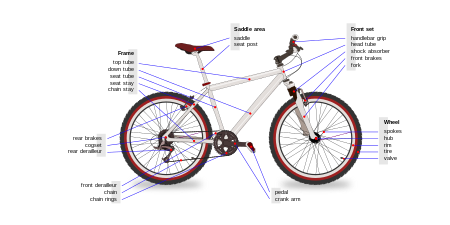 | |
| Wheels | ||
| Drivetrain | ||
| Cabling | ||
| Peripherals | ||